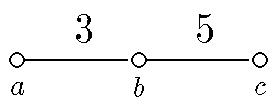



Each node x of a Coxeter graph
specifies a generator x and the relation 1=x2. If two
distinct nodes x,y in a Coxeter graph are joined by an edge with
label m where m is a positive integer, then this denotes the
relation 1=(xy)m. All the edges in our Coxeter graphs are labelled.
If two distinct nodes x,y in a Coxeter graph are
not joined by an edge, then this denotes the relation 1=(xy)2. We
specify a Coxeter graph
For example, the graph specified by the two paths a3b3c3d3a3c,b3d is the complete graph on a,b,c,d with all edge-labels 3. The Coxeter graph

is denoted by a3b5c, which also denotes the presentation < a,b,c| 1=a2=b2=c2=(ab)3=(bc)5=(ac)2 >
for 2xA5. Note that we demand a Coxeter graph to have at least one edge.